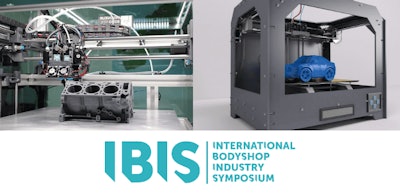
Toronto, Ontario – Recently, the Task Force group, composed of experts from various fields related to 3D printing, OEMs, additive materials, recycling and engineering released an assessment report on the benefits, challenges and future directions of 3D printing in the automotive industry.
According to the report, the Task Force group’s “efforts have been focused on engaging with industry stakeholders, conducting research on 3D printing applications, and identifying key areas for improvement.”
To produce the report, the task force visited prominent entities such as IBIS Global, HP’s Barcelona Facility, Thacham Research, ADAC Automotive, Carhart Products, Boyd Group and I-CAR.
Other areas of focus within the report included “addressing the risks associated with using poor quality 3D printed auto parts.”
The report identified a variety of benefits from incorporating 3D printing across all levels of the automotive industry, stating that “3D printing exhibits transformative potential in the collision industry, especially in manufacturing smaller short-run plastic components (and) for producing repair kits for headlights, sensor cradles, bumper covers and high-value clips.”
The use of 3D printing could also be used to address the need for smaller, discontinued or out-of-stock parts by allowing a manufacturer to have ready-made pieces.
The report further noted that “these innovative solutions could be distributed through an OEM or aftermarket supply model to enhance aftermarket offerings and align supply channels and repair parts with OEM standards in certain models.”
This could, in turn, “potentially pave the way for in-house desk-top printers in larger collision centers or those that support a hub-and-spoke model,” and that would allow repair centres to “significantly expedite the turnaround time for fixing damaged vehicles.”
Insurers could also benefit, the report finds, by standing to gain from reduced claim payouts, expedited settlements and heightened customer satisfaction through the ease of parts accessibility and the cost benefit of reduced materials and wait times.
Other critical advantages would include an ability to reduce cycle times and to “salvage parts that were once discarded due to missing or damaged plastic components.”
However, 3D printing does not come without its challenges. The report specifically identifies the risk of “an influx of substandard, unregulated parts from unverified or unlicensed sources attempting to capitalize” on new tech.
The risk of using poor-quality materials creates potential widespread concerns across the industry.
For repair centres and OEMs, there is a risk of safety concerns, incompatibility with other automotive parts, warranty and insurance issues, as well as the potential for damage to reputation.
For established and recognized 3D printing providers, concerns over faulty or unlicensed products create the potential for market confusion, price pressures, and also reputation issues.
The task force finishes the report with future recommendations of establishing a regulatory authority to monitor 3D printing; developing industry-wide quality standards and validation protocols; creating certification programs for 3D printing materials; and enforcing penalties for non-compliance.
To read the report in full, check out the link below:























